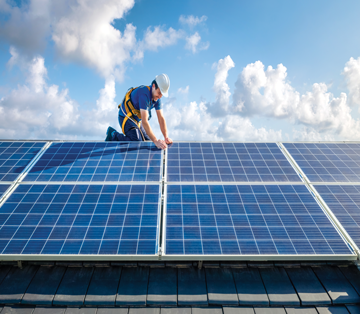
Code compliance for rooftop building-integrated photovoltaic systems, including PV shingles, is complex. BIPV systems have dual functionality as a roof covering and electricity-generating product. This dual functionality can lead to confusion and disputes about who should install and maintain such systems. In addition, various code requirements further complicate the issue.
IRC 2021
The International Residential Code,® 2021 Edition defines a solar energy system as a system that converts the sun’s solar radiation into usable energy. Solar energy systems include solar thermal and PV systems.
The code further defines a building-integrated product as a building product that incorporates PV modules and functions as a component of the building envelope, such as a roof covering.
The code defines PV shingles as a roof covering resembling shingles that incorporates PV modules.
IRC 2021’s Section R324-Solar Energy Systems provides general requirements applicable to solar energy systems. Section R324.3-Photovoltaic Systems indicates the electrical portion of PV systems needs to be designed and installed in accordance with the 2000 edition of NFPA 70, “National Electrical Code.®” PV panels and modules, including BIPV, are required to be listed and labeled in accordance with UL 1703, “Standard for Flat-Plate Photovoltaic Modules and Panels,” or both UL 61730-1, “Photovoltaic (PV) Module Safety Qualification—Part 1: Requirements for Construction,” and UL 61730-2, “Photovoltaic (PV) Module Safety Qualification—Part 2: Requirements for Testing.”
Rooftop PV systems specifically are addressed in IRC 2021’s Section R324.4-Rooftop-mounted Photovoltaic Systems, where dead, live, snow and wind load requirements are provided. Section R324.6-Roof Access and Pathways provides specific requirements for roof access pathways, setback at ridges, and emergency escape and rescue openings.
IRC 2021’s Chapter 9-Roof Assemblies provides roofing-specific requirements for BIPV. Section R902.3-Building-integrated Photovoltaic Products requires rooftop BIPV to be tested, listed and labeled for fire classification in accordance with UL 7103, “Outline of Investigation for Building-Integrated Photovoltaic Roof Coverings.” Class A, B or C BIPV assemblies are required where fire classification is designated by the authority having jurisdiction or where the roof edge is within 3 feet of a lot line.
IRC 2021’s Section 905.16-Photovoltaic Shingles specifically requires PV shingles to be applied to a solid or closely fitted deck except when a product is designed to be applied over spaced sheathing. Roof slopes are required to be 2:12 or greater. Underlayment, ice barrier and wind-resistance classification requirements for PV shingles are similar to those of other shingle-type roof coverings. PV shingle attachment and installation are required to follow PV shingle manufacturers’ installation instructions.
IRC 2021’s Section R905.15-Building-integrated Photovoltaic (BIPV) Roof Panels Applied Directly to the Roof Deck addresses rooftop BIPV other than PV shingles. Roof deck, deck slope, underlayment, attachment and installation requirements are similar to those of PV shingles. The code requires BIPV products other than PV shingles to be designed and installed for wind uplift to resist component and cladding loads.
NFPA 70
The electrical code addresses photovoltaic products and installations, including array circuits, inverters and controllers, in Article 690-Solar Photovoltaic (PV) Systems. Article 690 provides specific general requirements, circuit requirements, disconnecting means, wiring methods and materials, grounding and bonding, marking, connections to other sources, and energy storage systems.
For one- and two-family dwellings, the maximum DC voltage in a PV string circuit leading into a DC combiner cannot exceed 600 volts.
Article 690.4(C) indicates: “The installation of equipment, associated wiring and interconnections shall be performed only by qualified persons.” According to Article 100-Definitions, a qualified person is “one who has skills and knowledge related to the construction and operation of the electrical equipment and installations and has received safety training to recognize and avoid the hazards involved.”
It should be noted Article 690 has undergone several changes among its 2014, 2017, 2020 and 2023 editions. Although IRC 2021 specifically references NFPA 70’s 2020 edition, an individual authority having jurisdiction may adopt any edition of the electrical code. Typically, the specific edition of NFPA 70 adopted by the authority having jurisdiction will take precedence over the edition referenced in the IRC. This can affect the electrical code’s specific requirements for rooftop BIPV.
Closing thoughts
Because of the dual functionality of rooftop BIPV, code compliance is not as straightforward as in the case of conventional roof systems. For one- and two-family dwellings, code requirements are provided in multiple chapters of the IRC and NFPA 70.
For nonresidential buildings, code requirements are provided in the International Building Code,® NFPA 70 and the applicable fire code.
The issue of whether electrical or roofing contractors should be responsible for rooftop BIPV installation is debatable. Some suggest the electrical code requires the work to be conducted by licensed electricians. NFPA 70’s Article 690.4(C) and IRC’s requirements clearly do not specify who should install such systems. The code indicates installers should be skilled, knowledgeable and have safety training to recognize and avoid hazards. This type of instruction should be provided by rooftop BIPV manufacturers in their installation instructions and installer training.
There appears to be a clear, logical line between work best performed by a roofing contractor and work performed by an electrical contractor. Properly trained and experienced roofing workers are the most logical choice to perform rooftop installation, including rooftop BIPV installation. A properly trained, experienced, licensed electrician can be used for work below the roof deck, including wiring and connecting BIPV to any inverter or the power grid. One line of demarcation between the two trades is the DC combiner. Roofing crews should conduct the BIPV installation on the rooftop PV-side of the DC combiner, and an electrician’s work should involve the DC combiner and any inverter or the power grid.
Some roofing contractors experienced in rooftop PV installation employ licensed electricians specifically for this purpose. In other situations, roofing contractors can subcontract one or several electrical contractors to perform electrical work. Either approach is appropriate for rooftop BIPV.
Some may disagree with me; however, we all know when homeowners have problems with their roofs, they will call a roofing contractor—not an electrical contractor.
MARK S. GRAHAM is NRCA’s vice president of technical services.
@MarkGrahamNRCA



